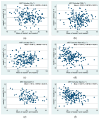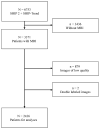Normative Values for Sternoclavicular Joint and Clavicle Anatomy Based on MR Imaging: A Comprehensive Analysis of 1591 Healthy Participants
- PMID: 38930127
- PMCID: PMC11205057
- DOI: 10.3390/jcm13123598
Normative Values for Sternoclavicular Joint and Clavicle Anatomy Based on MR Imaging: A Comprehensive Analysis of 1591 Healthy Participants
Abstract
Background: The clavicle remains one of the most fractured bones in the human body, despite the fact that little is known about the MR imaging of it and the adjacent sternoclavicular joint. This study aims to establish standardized values for the diameters of the clavicle as well as the angles of the sternoclavicular joint using whole-body MRI scans of a large and healthy population and to examine further possible correlations between diameters and angles and influencing factors like BMI, weight, height, sex, and age. Methods: This study reviewed whole-body MRI scans from the Study of Health in Pomerania (SHIP), a German population-based cross-sectional study in Mecklenburg-Western Pomerania. Descriptive statistics, as well as median-based regression models, were used to evaluate the results. Results: We could establish reference values based on a shoulder-healthy population for each clavicle parameter. Substantial differences were found for sex. Small impacts were found for height, weight, and BMI. Less to no impact was found for age. Conclusions: This study provides valuable reference values for clavicle and sternoclavicular joint-related parameters and shows the effects of epidemiological features, laying the groundwork for future studies. Further research is mandatory to determine the clinical implications of these findings.
Keywords: MRI diagnostics; SHIP; clavicular anatomy; reference values; sternoclavicular joint.
Conflict of interest statement
The authors declare no conflicts of interest. The funders had no influence in the design of the study, in the collection, analysis, or interpretation of data, in the writing of the manuscript, or in the decision to publish the results.
Figures












References
-
- OECD and European Union . Availability and Use of Diagnostic Technologies. OECD; Paris, France: 2018. - DOI
-
- Guglielmi G., Cascavilla A., Scalzo G., Salaffi F., Grassi W. Imaging of sternocostoclavicular joint in spondyloarthropaties and other rheumatic conditions. [(accessed on 2 June 2024)];Clin. Exp. Rheumatol. 2009 27:402–408. Available online: http://www.ncbi.nlm.nih.gov/pubmed/19604431. - PubMed
Grants and funding
LinkOut - more resources
Full Text Sources

